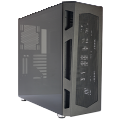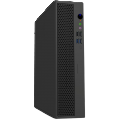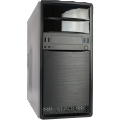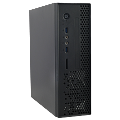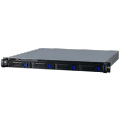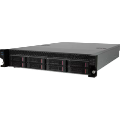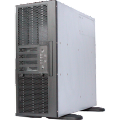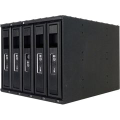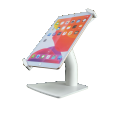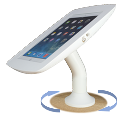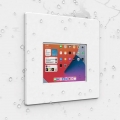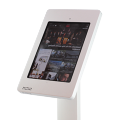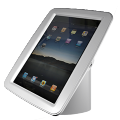CASE STUDY -Introducing the NEW 8L microATX computer case
Case Study-Introducing the NEW 8L microATX computer case
3 Trends in Computer Industry
It’s been decades since the first computer came to the world in 1940s. The application and the design of the computer have changed tremendously, from gigantic a vacuum tube monster “calculator” to cubic universal machine with hundreds of ICs. However, there’s three trends never changed: performance improvement, power control, and miniaturization
Trend: Performance improvement
The performance improvement is the main force driving the advance of the computer. In the 1940s, the first vacuum tube computer could only calculate 5000 instructions in a second and its storage was only few KB, far from the spec nowadays. In the meanwhile, it consumed lots of power while generating unignorable heat. The storage media it used: paper, was also fragile and hard to maintain. It was easily suffered from the threat from fire, flood and pest.
Only when the transistors were introduced into the computer, the performance of the computer get apparent upgrade. Its calculation ability grew in thousand-fold and gained in a rate of 10-fold per decade. The join of the gradually matured IC and the manifesto of Moore’s Law further accelerated the progress: in less than a year, the growth rate of calculation ability increased four-fold (Pentium P5 to Pentium P6).
With the rapid development and competition, the function of computers increased dramatically. More programs were created and the most important: the price dropped. Computers became useful and affordable. It was no longer a colossal machine hide in military or government department or big companies anymore; instead, it stepped into publics. Since then, it has gained more impact and started to be an essential equipment in the modern world.
Until now, it is still evolving. New theory and design keep lead its development. ICs with advanced fabrication process to improve its ability are also in research because new technology like AI and autopilot highly relies on it. As we want the help from the computers more, we’ll dedicate more to improve it. The power of the computer will definitely the keystone in future technology.
Trend: Energy control
When the computer started to popularize, the energy consumption became an inevitable issue. No government, even publics can afford such a high power-draining machine. This led to the low popularity of the computer. Not to mention the strict requirement on the cost, the space, and the training of technicians.
At the beginning, when the first computer, the room-filled metal skin pillar golem, came to the world, the developers had recognized it as a main, urgent problem. However, limited to the structure and the hardware performance, the power problem cannot be solved in a short time. Hopefully, the emergence of transistors opened a shortcut to solve the issue.
The transistors improved the transmission pathway of the electrons. In transistors, the electrons no longer need to be emitted from electrodes to the vacuumed chamber; instead, the electrons can finish the journey in silicon-based, single state substrate. This greatly reduces the threshold voltage to start the process to alter the state of the byte. Also, the fabrication process can be simplified and automized. The production cost is reduced and controlled. In summary, transistors had the advantage on the size, the cost and power saving, compared to the huge vacuum tube.
The successor of transistors, the IC, continued the concept and push the technique to the limit. The wire width has shrunken from mm to nm, in million grades. The power consumption dropped magnificently with this progress. Nowadays, a CPU with thousands of cells consume the same power as one vacuum tube. Even so, the power consumption still an important issue. However, it no longer belongs to the traditional computer. It becomes a nightmare to mobile computer.
Trend: Miniaturization
When the performance and the power issues solved, the eager from researchers to explore the limit came after it.
Thanks to the invention of transistors, scientists no longer needed to use the bulky vacuum tubes. They started to simplify the design, reducing the unnecessary space. In the meanwhile, new technology and new material brought new possibilities. The lithography improved the semiconductor fabrication techniques. Smaller wires can be produced by only few steps of deposition and etching by the help of new selective etching solution, the photoresist and deposition machines. The shrinkage of components and the mature of multilayer circuit board facilitated the success of the miniaturization. No big control boards, no big paper cartridges, no sophisticated wire routings, all were integrated into a 12*9 square centimeter size mother board.
The trend happened to the power supply also. Because the power consumption dropped when the vacuum tubes were substituted, the computer system never needed the generator-like power supplies. The power supplies were minimized by taking the advantages of the micromachining with advanced strong magnetics while remaining the efficiency. In addition, the miniaturization gave birth to the development of storage devices. The multidisc hard disk came to the world after the transistors.
With the components’ size reduced and standardized, the computer started to be smaller and powerful. The portable computer then had the chance to be realized.
Birth of the 8L chassis
Today, the trend of performance improvement, power control, and miniaturization still continue: In the hardware side, the formfactor of motherboard changed from ATX to Mini-ITX, the HDD went from 3.5” to 2.5” or even M2 storage key, the PCIE card reduce from standard to low profile. In the CPU side, the number of cores went up from one to 32 or even 64 and the power consumption only went 17 folds compared to the 40 folds clock frequency growth and the 8 folds number of cores growth. The light and thin laptops were built on the trend and this wind blew back to the personal computer also. People started to find they don't need big cases to install the big components and the huge cooler to help dissipate the residual heat anymore. The medium or even low performance hardware nowadays can satisfy the casual tasks and they are energy saving. It rises the need for small form factor chassis and also give us a reason to develop our new case series.
The new 77xx 8L series was created to answer the need. Whereas, it's a big challenge to the standard design guide. Considering the clearance zone of the mother board, PSU, PCIE card, storage devices and peripheral components on the front panel, a micro ATX case must be around 11L to 12L in standard design, such as our 73xx series. The only 3L difference troubled us for a long time. After consistent gathering the information from the market, we finally saw a light through the breach. As the saying goes, “there is no progress or accomplishment without sacrifice.” We made some compromise. Finally, by the years design experience and the knowledge of cutting-edge fabrication technique, our engineer team successfully finish the mission impossible, compressing the case volume from 11L to 8L and remaining the greatest compatibility with hardware. What’s better, even the size was reduced, the new case can still install TFX power supply, micro ATX motherboard, two 2.5" HDD and 1 3.5" HDD. The expansibility is also upgraded. It has new options like SD card reader and USB type C.
However, there is a price. To shrink the size, there must be some trade-offs: the gap between each component must be reduced and only specific devices are allowed to be installed in some circumstance, but the thermal issues, the assembling difficulty will rise. In the meanwhile, the cost will also rise because some of the component my need to be customized to fit into the small chassis. This issue can easily be observed on the products of tier 1 PC companies like HP, Dell, and Lenovo. Lots of customized components are used in the case. This phenomenon lift the barrier for newcomers and small PC system integrators.
Fortunately, our engineers made a great balance. We maximized the compatibility to standard PC components. We allowed standard 4 PCI slots micro ATX motherboard to fit in. We kept the air partition to help cool the CPU. The cooling fan was also preserved intentionally to drive the air flow. To give the technicians a better experience, we carefully designed the structure and added toolless function to ease the inconvenience when assembling the system. The compatibility of TFX power supply extinguished us from other competitors on the market and make the case more flexible and competitive on function and cost control. With above attractive features, we highly recommend this case as your first case platform to start the business on the PC market.


